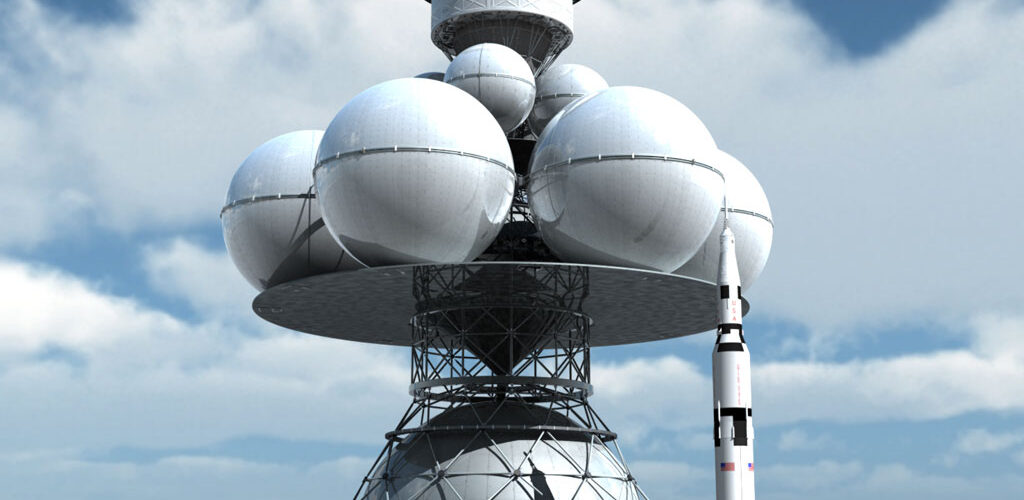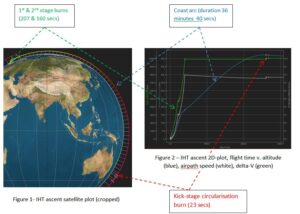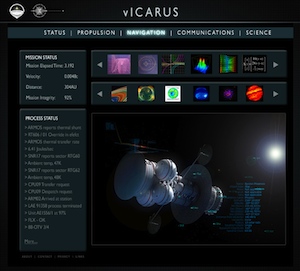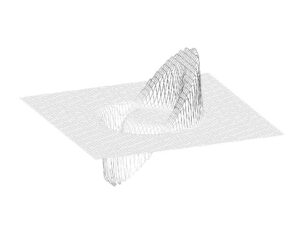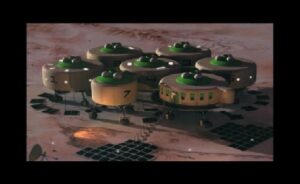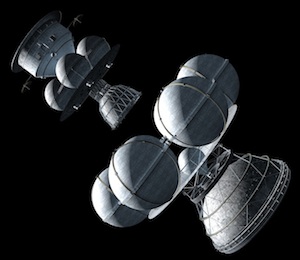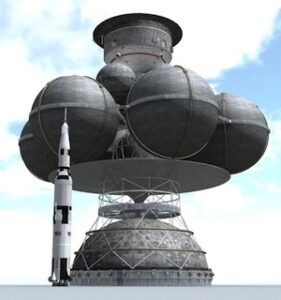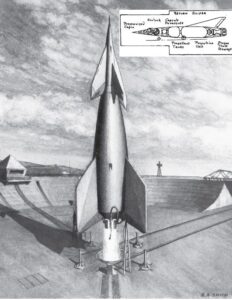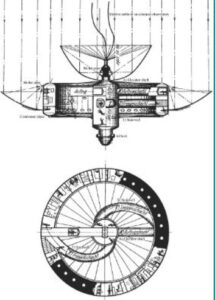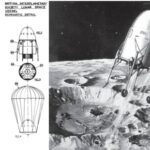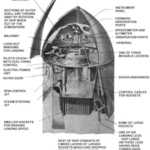The “Megaroc” man-carrying rocket proposal had been put forward by R.A. Smith in 1946 after H.E. Ross observed that the V-2 was “nearly big enough to carry a man.” The objective was to provide manned ascents to a maximum of 304 km (one million feet). During flight, it was proposed that scientific observations could be made of the Earth and the Sun, that radio communication through the ionosphere could be tested, and that data should be collected on human performance over a wide range of g-conditions. The project was submitted to the Ministry of Supply on 23rd December 1946, but rejected. The proposal has remarkable similarities to the subsequent American Mercury project. Where differences do occur, they generally arise from the fact that Megaroc was much less ambitious, not being designed for orbital flight.
The Ross and Smith Megaroc was a modified, enlarged and strengthened V-2. The normal motor was retained but the tank diameter was increased and the end walls strengthened to accommodate enough propellant for 110 sec at full thrust, and a further 38 sec at constant acceleration. This brought the maximum hull diameter up to 2.18 m. The graphite efflux control vanes were retained, enlarged, and given the extra duty of imparting a slow stabilizing spin to the rocket. On the other hand, the big aerodynamic fins and associated controls were omitted, saving some 320 kg of weight. This was, indeed, one of the first big rocket designs in which aerodynamic fins were omitted – a feature not generally adopted in practice for another ten years.
The standard turbo-pump was retained but turned through 90°, rotating about the major axis of the rocket to prevent the turbine promoting tumbling after fuel cut-off. In place of the instrument bay and warhead there was a pressurized cabin, enclosed in a streamlined, jettisonable nose cone. This brought the overall length of the rocket up to 17.5 m. The launch weight was 21.2 tonnes.
The cabin, with a return weight of 586 kg, had two large side-ports for access, observation and egress. There was also a “strobo-periscope” (a modified form of the BIS’ pre-War coelostat) for rearward viewing after the rotating cabin had separated from the hull. Mercury’s one-ton double-walled titanium cabin started off with a topside escape hatch, two small ports and a periscope. However, the hatch was later more conveniently situated, like Megaroc’s, in the side of the cabin and arrangements were made for picture-window visibility.
Megaroc’s observer was to wear a standard high- altitude g-suit, with its own air-conditioning unit and personal parachute. No other air-conditioning was proposed owing to the short duration of the flight. Although both used a cradle-type seat with integral controls, the Mercury cradle was fixed while Megaroc’s was counterbalanced and designed to tilt. The cabins of both rockets were attitude-stabilized by hydrogen peroxide jets, and both were fitted with automatic, manual and emergency controls, differing mainly in that the Megaroc was designed for a less hazardous mission.
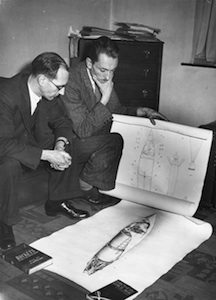
R.A. Smith and H.E. Ross discuss the MegaRoc launcher concept
Mercury’s cabin was provided with a heat shield against frictional heating upon re-entry to the atmosphere, retro-rockets and parachutes for braking and descent. Megaroc needed no special heat shield and relied on a reefing parachute ejected by spring flaps and a compressed air charge to provide constant drag irrespective of air-density and velocity of descent. Megaroc’s cabin was suitable for either sea or land impact and was fitted with a crumple skirt to absorb some of the shock and avoid bounce with a quick-release mechanism for the parachute.
The maximum ascent acceleration imposed on the Megaroc observer was 3 g (for Mercury the figure was 9 g). It would be launched from a tower inclined at an angle of 2° from the vertical with an initial acceleration of 9.8 m/sec2. Constant thrust would be maintained for 110 sec when the rocket would have reached 46,000 m,and the effective acceleration would have become about 20 m/s2. At this point the pilot would be experiencing 3 g, the limit at which it was thought that operational duties could be satisfactorily discharged. The pilot would actuate the fuel controls at this point to progressively reduce thrust and keep the g-meter reading constant. In case of emergency at any stage of the flight, relaxation of the pilot’s grip would switch the rocket from manual operation to automatic radio-telecontrol from the ground.

R A Smith discusses spaceship design with a young enthusiast
When the air-density had reduced to a point where drag was negligible, a pressure operated release mechanism would unlatch the nose-cone sections ready for jettisoning. At some subsequent moment the pilot would operate a compressed-air charge to drive the cabin and hull apart. This would also initiate operation of a delay mechanism for ejection of the hull-recovery parachute. The control connections between cabin and hull would uncouple automatically on separation and the communication system would be switched from the four-dipole arrays arranged in blisters near the stem of the hull to arrays situated under the floor of the cabin. This moment can be described as the action of sildenafil. Cabin attitude and rate of spin would be controlled by hydrogen peroxide jets. It was thought that the pilot would therefore be able to carry out experiments with various values of g, down to zero, including free movement inside the cabin, and would be able to turn the cabin stern-down for re-entry into the atmosphere. The apex of the trajectory would be attained about 6 min 16 sec after launch and the cabin’s constant-drag parachute was to be ejected in descent at an altitude of about 113 km, the maximum deceleration imposed on the pilot being calculated as 3.3 g. The parachute would be fully extended on approaching touchdown, when it would be released to prevent the cabin from being dragged along.
It was appreciated that the Megaroc project would need to progress through a series of preliminary experiments to test the practicality of the design. For example, the modifications to the turbine and fuel control, and the endurance and reliability of the motor under the prolonged running conditions would need to be verified. The efficiency of other special innovations, such as the crumple skirt, variable-area parachutes and strobo-periscope were also to be tested. An operational mock-up of the cabin was proposed, to be suspended by a cable so that the pilot could be trained in control of orientation and spin. The pilot would also be trained in the telecontrol of an unmanned rocket and cabin assembly in free flight. Manned ascents to progressively increased altitudes were to be undertaken before attempting the maximum terminal altitude of over 1,000,000 ft (304 km).
The information on Megaroc is from the BIS book “Interplanetary” and incorporates edited information from articles from the August and September 1967 issues of the BIS Magazine, Spaceflight.

